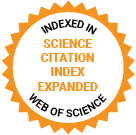Journal of Medical Internet Research
The leading peer-reviewed journal for digital medicine and health and health care in the internet age.
Editor-in-Chief:
Gunther Eysenbach, MD, MPH, FACMI, Founding Editor and Publisher; Adjunct Professor, School of Health Information Science, University of Victoria, Canada
Impact Factor 5.8 CiteScore 14.4
Recent Articles

The global aging population faces great challenges. Wearable activity trackers have emerged as tools to promote physical activity among older adults, potentially improving health outcomes. However, the effectiveness of such interventions on physical activity, body composition, and physical function among community-dwelling older adults remains debated.


People living with HIV/AIDS face multiple challenges that collectively impede their adaptation outcomes. These outcomes include quality of life (QoL), acceptance of illness, mental health (including symptoms of anxiety and depression), and antiretroviral therapy (ART) adherence. While existing evidence addresses specific challenges, it often overlooks the interactions among the various problems people living with HIV/AIDS encounter. The comprehensive-task disease management framework and positive self-management framework provide a theoretical basis for understanding the adaptation process. A culturally tailored, theory-based intervention may be necessary and effective in facilitating better adaptation outcomes for people living with HIV/AIDS.

Patients’ electronic access to their health information can improve long-term health outcomes. Few studies have evaluated barriers that may limit access to portal health information before the COVID-19 pandemic such as preference for in-person visits, lack of perceived need to use a patient portal system, and lack of comfort or experience with computers. With the increased use of telehealth during the pandemic, patients’ comfort with portal applications and digital health literacy has improved.


Digital health care self-monitoring has gained prominence as a tool to address various challenges in health care, including patient autonomy, data-informed decision-making, and organizational improvements. However, integrating self-monitoring solutions across a diverse ecosystem of stakeholders—patients, health care providers, policy makers, and industry—can be complicated by differing priorities and needs.

The proliferation of internet-based health information has intensified cyberchondria, or anxiety resulting from excessive health-related searches. The relationship between cyberchondria and suicidal ideation remains underexplored, although there are indications that people with high levels of cyberchondria may also be suicidal. Understanding this relationship is critical, given rising digital health-seeking behaviors and the need to mitigate suicide risk. Emerging evidence suggests that psychological distress can mediate the relationship between cyberchondria and suicidal ideation. However, to the best of our knowledge, no research has directly examined these associations.

The last decade has witnessed major advances in the development of artificial intelligence (AI) technologies for use in health care. One of the most promising areas of research that has potential clinical utility is the use of AI in pathology to aid cancer diagnosis and management. While the value of using AI to improve the efficiency and accuracy of diagnosis cannot be underestimated, there are challenges in the development and implementation of such technologies. Notably, questions remain about public support for the use of AI to assist in pathological diagnosis and for the use of health care data, including data obtained from tissue samples, to train algorithms.

Delirium in intensive care unit (ICU) patients poses a significant challenge, affecting patient outcomes and health care efficiency. Developing an accurate, real-time prediction model for delirium represents an advancement in critical care, addressing needs for timely intervention and resource optimization in ICUs.

Men who have sex with men have a disproportionately high prevalence of HIV worldwide. In Brazil, men who have sex with men account for over 15% of HIV cases, substantially higher than the general population prevalence of 0.6%. Pre-exposure prophylaxis (PrEP) is a critical biomedical strategy for reducing HIV transmission, yet adherence remains challenging due to stigma, logistical barriers, and the need for regular clinical follow-ups. TelePrEP, a telehealth-based approach to PrEP follow-up, has emerged as a potential solution to improve accessibility and reduce stigma. However, the perspectives of users and health care providers on this intervention remain understudied in low- and middle-income countries, such as Brazil.

Symptom checker apps (SCAs) are layperson-facing tools that advise on whether and where to seek care, or possible diagnoses. Previous research has primarily focused on evaluating the accuracy, safety, and usability of their recommendations. However, studies examining SCAs’ impact on clinical care, including the patient-physician interaction and satisfaction with care, remain scarce.
Preprints Open for Peer-Review
Open Peer Review Period:
-
Open Peer Review Period:
-
Open Peer Review Period:
-
Open Peer Review Period:
-
Open Peer Review Period:
-

















